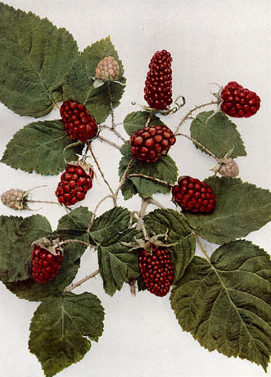How to Grow Loganberries – A Guide to Growing Loganberries
 Loganberries are often said to be a cross between a raspberry and a blackberry but the truth is that they’re probably a blackberry sport (mutation). They were originally grown in 1881 by Judge James H Logan of California who sowed some American blackberry seed and these popped up.
Loganberries are often said to be a cross between a raspberry and a blackberry but the truth is that they’re probably a blackberry sport (mutation). They were originally grown in 1881 by Judge James H Logan of California who sowed some American blackberry seed and these popped up.
Loganberries
Loganberries are very similar to blackberries but more tart in flavour, most people prefer them cooked to fresh. Great for Jam. Very thorny but a thornless slightly less vigorous strain, L654 is available
Growing Loganberries
- Cultivate as for blackberries
- Container grown plants can be planted at most times of the year, as long as the ground is not too wet, or frozen.
- Plant bare rooted berries in November–December.
- Harvest late summer–early autumn.
- They are self-fertile so you’d need only one plant. Each flower makes one berry.
- Bare-rooted loganberries are best planted during their dormant season in November-December before the ground becomes frozen or too wet. Or, as late as March in non-soggy soil Container plants can be planted any time.
- Full sun is an ideal location
- For ground plants, space about 2 m (6 ft) minimum between plants to allow for the inevitable suckering. Along fences is ideal to better deal with the vigorous growth. Wherever a cane touches the ground, it will immediately root.
- Dig a hole larger and deeper than the container, add a handful of bonemeal and some rotted manure and mix into the soil. Blackberries aren’t too fussy about their soil but some manure will aid a good crop as they prefer slightly acidic soil
- Fill in with soil or soil mixed with some compost, firm soil in so it’s at the original pot growing point, and water well. Once established, blackberries easily survive with little water but do best with regular watering, particularly at fruit ripening times. In drier areas, drip lines are ideal.
- Prune the existing shoots/canes to about 22cm (9 inches)
- Immediately add a large, strong support system to keep the rampant canes under control.
- The fruit develops on one-year-old canes (shoots). Tie the shoots to wires to keep them easy to crop, to make pruning easier and to ensure a good flow of air around the fruit.
- An easy method of training the fruit is a sort of alternating cordon method; train this years’ canes to one side, the next year’s growth on the other side. After fruiting, the first side is cut off at ground level. In this way the fruiting side alternates each year.



